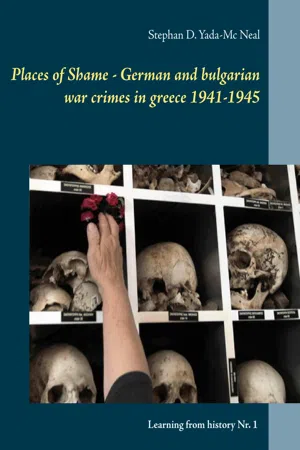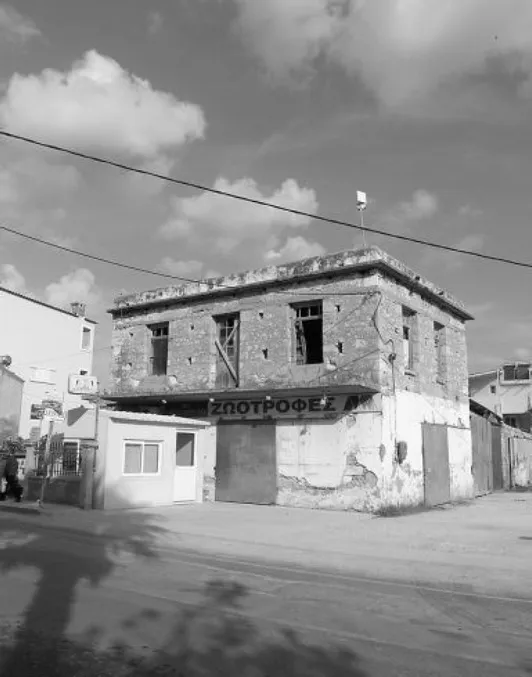![]()
Places
of
Shame
![]()
Perivolia - Misiria – 23. May 1941
The executions at Misiria are probably the earliest, perhaps the first, acts of reprisals against civilians in Greece during WWII. On 23 & 24 May 1941 some 60 people were executed at the beach in Misiria, a small settlement at the eastern outskirts of Rethimno town.
The German forces that landed in Rethimno area realized immediately that they were facing armed opposition not only from regular troops, but from civilians as well.
At Perivolia in Rethimnon, their reaction to the fact was the capture, on the 21 of May, of a large number of civilians as hostages (some140). The captives were held in two buildings, the Dulumpeki Café and the Ioannis Melissurgos residence.
On the afternoon of 23d May, after some more episodes of paratroopers being killed by insurgents, the Germans summoned 36 men at the beach in Missiria and executed them (4 of them fled 3 survived). Another party of 32captives (including women) faced execution in the same area at the same time, but most of them (apart seven) were saved when an Australian artillery unit started shelling the beach.
On the next morning, of May the 24th, some 17 older men were picked up from the Dulumpeki Café and were executed at the same area. Their bodies were incinerated at the spot after they were soaked in gasoline.
The dead from the previous day were dumped in a nearby well, which was filled to the top. The execution area became a place of commemoration as early as 1943. The memorial that stands now in the execution area was built in the late 70s. The marble relief in its center was situated originally on the allied cemetery that once stood close by.
The Douloumpeki Building
German Paratrooperss captured some 50 civilians and imprisoned them in here in 20 May 1941. They were executed among other captives on 23d and 24th in the nearby seashore, in one of the earliests acts of reprisals against civilians in Greece.
The building
It is known by the name of its owner which was Theodoros Douloumpekis. In 1941 this building (probably one store only) was a used as cafe shop and was among the few houses astride the "National" road in Misiria.
When German Paratroopers fell and occupied this area in 20th May 1941 they used this building among several others in the area as a defensive stroghold.
The Execution at Misiria
The actual cause of the imprisonment it is knot known but it seems that the Germans where outraged by the fact that civilian population was facing them and inflicting many casualties. Finding themselves under unfavorable circumstances the probably considered safe to take some prisoners as precaution.
When the next day they discovered that one of their comrades that was send to bring water was found slaughtered (probably by civilians since no tactical units were present nearby this area) they unleashed their wrath on the prisoners.
The captives were marched down the road 20 meters W to the seashore. They were put in a line and were fired by a squad of some 10 men. During the execution, Australian artillery guns that were situated in hill A some 4 km to E opened fire to the Germans, causing a disorder. Four men from the convicted found the opportunity to escape, one of them died from wounds.
The church of Ayios Georgios was one of the epicenters of the battle at Perivolia in May 1941. A number of Paratroopers found shelter in the church and fought for ten days a hard battle of survival, surrounded by insurgents as well as Greek and Australian forces.
A large group of German paratroopers were drooped at the low hills south of Perivolia. After an original attempt to press toward Rethimnon town they faced great resistance and were forced to retreat.
The group took cover in the Perivolia settlement creating a pocket of resistance, turning its buildings, among them Ayios Georgios, into strong holds. The Australian troops, aided by elements of Greek armed units and Cretan insurgents, attacked the Perivolia pocket from almost all directions several times.
They German forces were able to hold positions at Perivolia, in a bitter 10 days battle. At the 30th of May they were relieved by troops of the 5th division advancing from the Chania area.
The walls of the church have been plastered after the war, so numerous bullet holes are today not visible on the church. Nevertheless the ferocity of the fighting is still evident on the marble parts of the building, which still carry the marks of that conflict.
(Source: http://remnants.gr)
![]()
Kondomari . 02. June 1941
The place
Kondomari (municipality of Platanias) has about 250 inhabitants and is located near Maleme, the beginning of the 1940s, the largest airfield in Crete. The place was completely destroyed on 2 June 1941 by German soldiers in the context of a "retaliatory measure".
The event
After the German attack on Crete, carried out from May 20 to June 1, 1941 (see: Airborne Battle of Crete, Operation Mercury) could be "successfully" completed only with very large losses, and the assumption that the population of German troops was received in a friendly manner, also proved to be fallacious, were (unassailable) atrocity stories circulated by criminals Massakrierungen German soldiers spread. These served the commander of the German troops, General Kurt student, before their investigation as a justification for his even under then prevailing military international law criminal order of May 31, 1941, with which he ordered brutal retaliatory measures against the civilian population:
"[...] As retaliatory measures come into question: 1.) Shooting 2.) Contributions 3.) Burning of villages 4.) Extermination of the male population of entire areas. [...] It is now important to carry out all measures with the utmost speed, leaving out all the formalities and consciously eliminating special courts. In the whole situation, this is the task of the troupe and not of ordinary courts. They are out of the question for beasts and murderers. [...] "(quoted from Bundesarchiv-Militärarchiv, BA-MA, RH 28-5-4b, pp. 412f.)
On the basis of this revue order drove on June 2, 1941 a paratroop commando led by Lieutenant Horst Trebes (1944 in Normandy) in Kondomari all male residents of the village together in an olive grove and shot dead over 20 civilians (the figures vary victim numbers; Memorial is listed 23 names). After that, the entire place was destroyed.
![]()
Alikianos – 02. June 1941 and 01. August 1941
The place
The village of Alikianos, southwest of Chania, belongs to the municipality of Moussoura. The place was twice during the German occupation of Crete 1941 the scene of massacres of the civilian population.
The events
1st massacre on 2 June 1941
After the German attack on Crete, carried out from May 20 to June 1, 1941 (see: Airborne Battle of Crete, Operation Mercury) could be "successfully" completed only with very large losses, and the assumption that the population of German troops was received in a friendly manner, also proved to be fallacious, were (unassailable) atrocity stories circulated by criminals Massakrierungen German soldiers spread. These served the commander of the German troops General Kurt student before their investigation as a justification for his even under then prevailing military international law criminal order of 31 May 1941, with which he ordered brutal retaliatory measures against the civilian population:
"[...] Possible retaliatory measures are: 1.) Shooting 2.) Contributions 3.) Burning down localities 4.) Exterminating the male population of entire areas. [...] It is now important to carry out all measures with the utmost speed, leaving out all the formalities and consciously eliminating special courts. In the whole situation, this is the task of the troupe and not of ordinary courts. They are out of the question for beasts and murderers. [...] "(Bundesarchiv-Militärarchiv, BA-MA, RH 28-5-4b, Bl. 412f.)
On the basis of this revue order drove on June 2, 1941 a Sonderkommando in Alikianos the population in the church square together and shot 42 men.
The report, written by Nikos Kazantzakis, one of the most important Greek writers of the 20th century, for the Greek government in 1945 on war crimes committed by the German occupying forces on Crete, contains details of the events:
"On June 2, in the churchyard, they executed 42 men, before the eyes of their forced-to-watch women, as an act of atonement for the paratroopers killed during the attack. The doomed ones had to dig their graves by hand. After the Germans had taken their money, their rings and watches from them, they shot them in groups of ten and threw them each - instead of mercy shots - another grenade behind. Many have been buried alive. Eyewitnesses report that the earth thrown on those shot still moved away from the death convulsions of those buried "(quoted in Rondholz, p. 84).
2nd massacre on 1st August 1941
As part of a first special ...



